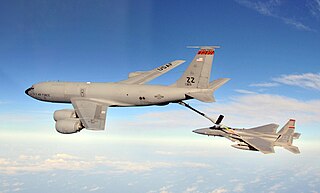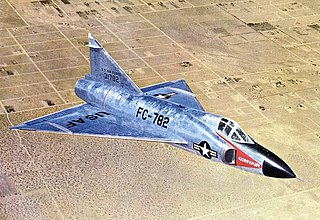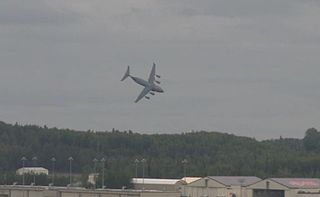
The Boeing KC-135 Stratotanker is an American military aerial refueling tanker aircraft that was developed from the Boeing 367-80 prototype, alongside the Boeing 707 airliner. It has a narrower fuselage and is shorter than the 707. Boeing gave the aircraft the internal designation of Model 717. The KC-135 was the United States Air Force (USAF)'s first jet-powered refueling tanker and replaced the KC-97 Stratofreighter. The KC-135 was initially tasked with refueling strategic bombers, but it was used extensively in the Vietnam War and later conflicts such as Operation Desert Storm to extend the range and endurance of US tactical fighters and bombers.

Richard "Dick" Ira Bong was a United States Army Air Forces major and Medal of Honor recipient in World War II. He was one of the most decorated American fighter pilots and the country's top flying ace in the war, credited with shooting down 40 Japanese aircraft, all with the Lockheed P-38 Lightning fighter. He died in California while testing a Lockheed P-80 jet fighter shortly before the war ended. Bong was posthumously inducted into the National Aviation Hall of Fame in 1986 and has several commemorative monuments named in his honor around the world, including an airport, two bridges, a theater, a veterans historical center, a recreation area, a neighborhood terrace, and several avenues and streets, including the street leading to the National Museum of the United States Air Force in Dayton, Ohio.

Williams Air Force Base is a former United States Air Force (USAF) base, located in Maricopa County, Arizona, east of Chandler, and about 30 miles (48 km) southeast of Phoenix. It is a designated Superfund site due to a number of soil and groundwater contaminants.

The North American F-100 Super Sabre is an American supersonic jet fighter aircraft designed and produced by the aircraft manufacturer North American Aviation. The first of the Century Series of American jet fighters, it was the first United States Air Force (USAF) fighter capable of supersonic speed in level flight.

The Convair F-102 Delta Dagger was an interceptor aircraft designed and produced by the American aircraft manufacturer Convair. A member of the Century Series, the F-102 was the first operational supersonic interceptor and delta-wing fighter operated by the United States Air Force (USAF).

The Distinguished Flying Cross (DFC) is a military decoration of the United States Armed Forces. The medal was established on July 2, 1926, and is currently awarded to any persons who, after April 6, 1917, distinguish themselves by single acts of heroism or extraordinary achievement while participating in aerial flight. Both heroism and extraordinary achievement are entirely distinctive, involving operations that are not routine. The medal may be awarded to friendly foreign military members in ranks equivalent to the U.S. paygrade of O-6 and below in combat in support operations.

Hill Air Force Base is a major U.S. Air Force (USAF) base located in Davis County, Utah, just south of the city of Ogden, and bordering the Cities of Layton, Clearfield, Riverdale, Roy, and Sunset with its largest border immediately adjacent to Clearfield and Layton. It is about 30 miles (48 km) north of Salt Lake City. The base was named in honor of Major Ployer Peter Hill of the U.S. Army Air Corps, who died test-flying NX13372, the original Model 299 prototype of the B-17 Flying Fortress bomber. As of 2018, Hill AFB is the sixth-largest employer in the state of Utah. Hill AFB is the home of the Air Force Materiel Command's (AFMC) Ogden Air Logistics Complex (OO-ALC) which is the worldwide manager for a wide range of aircraft, engines, missiles, software, avionics, and accessories components. The OO-ALC is part of the Air Force Sustainment Center.

Tactical Air Command (TAC) is an inactive United States Air Force organization. It was a Major Command of the United States Air Force, established on 21 March 1946 and headquartered at Langley Air Force Base, Virginia. It was inactivated on 1 June 1992 and its personnel and equipment absorbed by Air Combat Command (ACC).

The Lockheed C-141 Starlifter is a retired military strategic airlifter that served with the Military Air Transport Service (MATS), its successor organization the Military Airlift Command (MAC), and finally the Air Mobility Command (AMC) of the United States Air Force (USAF). The aircraft also served with airlift and air mobility wings of the Air Force Reserve (AFRES), later renamed Air Force Reserve Command (AFRC), the Air National Guard (ANG) and, later, one air mobility wing of the Air Education and Training Command (AETC) dedicated to C-141, C-5, C-17 and KC-135 training.

Otis Air National Guard Base is an Air National Guard installation located within Joint Base Cape Cod, a military training facility located on the western portion of Cape Cod in Barnstable County, Massachusetts, United States. It was known as Otis Air Force Base prior to its transfer from the active duty Air Force to the Air National Guard. In the local community, it is more commonly known as Otis Air Base or simply Otis. It was named in honor of pilot and Boston surgeon Lt. Frank "Jesse" Otis.

The South Vietnam Air Force, officially the Republic of Vietnam Air Force, was the aerial branch of the Republic of Vietnam Military Forces, the official military of the Republic of Vietnam from 1955 to 1975.

Da Nang Air Base (1930s–1975) was a French Air Force and later Republic of Vietnam Air Force (RVNAF) facility located in the city of Da Nang, Vietnam. During the Vietnam War (1959–1975), it was a major base with United States Army, United States Air Force (USAF), and United States Marine Corps (USMC) units stationed there. Air Vietnam also used the facility from 1951 to 1975 for civilian domestic and international flights within Southeast Asia.

General William J. Begert is a retired four-star general in the United States Air Force (USAF). He served as commander, Pacific Air Forces, and Air Component Commander for the Commander, United States Pacific Command, Hickam Air Force Base, Hawaii. As commander, he had responsibility for USAF activities spread over half the globe in a command that supports 55,500 airmen serving principally in Hawaii, Alaska, Guam, Japan and the Republic of Korea.

On July 28, 2010, a C-17 Globemaster III transport plane of the U.S. Air Force (USAF) crashed at Elmendorf Air Force Base in Alaska, while practicing for a flight display at the upcoming Arctic Thunder Air Show. All four crew members on board were killed. It is the only fatal accident of a C-17 aircraft.

Elmendorf Air Force Base is a United States Air Force (USAF) facility in Anchorage, Alaska. Originally known as Elmendorf Field, it became Elmendorf Air Force Base after World War II.
















